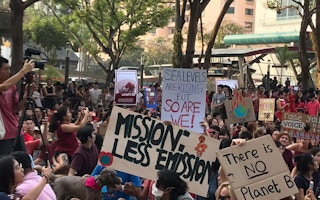What is climate action? The answer has taken a sharp turn in the past two years. It has evolved rapidly from a set of eco-friendly, individual-centric behaviours—using less plastic, turning air-conditioners off, taking public transport—to a wider movement that demands for industries to cut down on emissions and decarbonise.
With the general absence of environmental concern among Singaporeans, the environmental movement is now led by activists who conclude that calling out the big polluters is more impactful than advocating for individual actions since households only account for 6 per cent of carbon emissions in Singapore.
The individual only makes a miniscule impact with simple lifestyle changes like opting for one less straw. Claims in advertisements that you can ‘save the earth’ with small steps are clearly lies—they oversimplify solutions to the planetary breakdown.
Many conclude that this constant oversimplification is the reason why we have failed to alert people to the scale of the environmental crisis we are currently facing, why many Singaporeans continue to enjoy life in excess, or pick convenience over environment. Oversimplification is the reason why we have failed to increase recycling rates, see widespread aversion to fast fashion, or hear consumers demand products that are free from unsustainable palm oil.
“Don’t advocate for BYO (bring-your-own) and recycling,” you’ll see scribbled over social media posts. “They divert our attention from bigger issues like climate change and biodiversity loss.”
“Instead, we should be advocating for legislation changes to our biggest polluters, the industries!”. Indeed, a single policy to restrict emissions from industries has greater impact than individuals collectively using less straws.
But on closer scrutiny, stricter legislation is not enough. Lacking two critical components, policies alone will never get us where we need to be. We need more individuals to awaken to the reality of our many crises today, and we need to empower everyone with an earnest desire to change this reality.
Environmental issues are human rights issues
So why do we still fail to see a change in mindset today? There was a fundamental flaw with the previous style of advocacy. There had been little effort to integrate environmental and social issues. When we think about environmental disasters, the overt message on the detrimental impacts on Singapore assumes that citizens of the city-state will not care unless it directly affects them.
So we hear: Climate change is causing sea level rise in Singapore; climate change is causing a few degrees rise in average temperatures in tropical Singapore; single-use plastics are bad because they are overburdening Semakau landfill.
Amid this false dichotomy, most Singaporeans fail to recognise the human rights crisis unfolding behind the scenes.
They fail to see the stark health inequalities that their consumption habits are driving in developing countries, where people live next to pollution-belching industries and ever-expanding oil wells. They fail to see the degree of pollution that their buy-and-throw lifestyle is generating in neighbouring countries.
Due to the lack of connection between environmental and social issues, overconsumption remains a narrow landfill issue, not a human rights issue. Our call to safeguard the climate only grabs the attention of a small group of nature lovers, instead of everyone.
Some have also said that the focus on plastic pollution is distracting the environmental movement from the more significant issue of climate change, as fossil fuels account for 73 per cent of global greenhouse gas emissions. The truth of the matter is that climate change and plastic pollution are interconnected.
Framing the issue this way ignores the fact that industries are burning fossil fuels to produce plastics in the first place. In Singapore, we ease our worries with the thought that plastic waste is well-managed here, but this neglects the pollutive and hazardous ways that plastic is produced. Globally, over 600 million indigenous and local people are negatively affected by oil wells.
The connection between environmental and social issues is an unsettling realisation, so most people brush it aside as just another environmentalist’s hysteria or blame it on the incompetence of governments abroad.
“Stop exaggerating the problem and stepping on my rights. This is their problem, I have nothing to do with it,” these are the messages that I receive when I try to explain the importance of changing our current mindsets and lifestyles.
From my personal experience, two years of advocating to my own family has not been enough. Most people are only willing to take action within their comfort zone, and are unwilling to make the sacrifices necessary for moving our societies away from excessive consumption and extraction.
We must keep sharing the uncomfortable facts. It will take a long time for our society to accept that a lifestyle of luxury—buy-and-throwaway, using as much electricity as one likes or driving short distances—are highly unsustainable, even unjust.
Genuine concern and a heightened sensitivity to the impacts of our actions will drive change. With this knowledge, more people will willingly make sacrifices, knowing that their actions count towards the greater good. The change in mindset will naturally lead to the implementation of effective environmental policies.
Moving beyond carbon emissions
Although climate change is the result of man-made greenhouse gas emissions, measuring successful climate action by this metric alone sends the message that outcomes are what matters most.
Too many today view climate action with a single-minded lens, focusing on cutting emissions as the sole end-goal. Although that is definitely a key component to solving the climate crisis, using emissions levels as a benchmark of successful climate action risks perpetuating the misconception that environmental issues are just standalone problems of nature. The social injustices that are intertwined with environmental problems take a backseat.
Surely, there is another goal that is far more important to work towards. It is the development of a conscious mind, an acute sensitivity towards the well-being of communities impacted by a careless lifestyle, and a recognition that we are all interconnected in this ecosystem. Once more people realise that beneath the environmental damage is a profound human rights crisis, they will be moved to join the climate movement.
In this new reality, empathy flourishes and the true human spirit emerges. Other-centredness becomes our core guiding principle and our lifestyles are transformed. People lead conscious lifestyles to protect the rights of vulnerable communities who they may never meet. Active support for more ambitious environmental policies becomes second nature.
Never underestimate individual action
What if encouraging individual action leads to the misconception that it is enough to save the earth and stop climate change? There is no need to worry that one movement will overshadow another. Awakening to our many planetary crises may stem from the smallest actions.
It could start with using less plastic, which may lead to the individual thinking and wanting to know more about the topic. In this process, they inevitably learn about the oil industry, air pollution and health inequalities, and the exploitation of vulnerable communities. Then they may join citizen action groups and find new communities. Finally, the individual decides to take collective action.
Individual action will shape the way we think about our lifestyle, other peoples’ lifestyles, world inequality, and climate injustice. And that is when we truly understand that we are in a climate emergency.
All of us live in different kinds of environments, have different personalities and personal histories. Altogether, it shapes our different understandings of environmental damage depending on what strikes our hearts first.
It could be the excessive styrofoam containers, the litter you encounter at a cleanup activity, or coral bleaching. Where you start does not matter, because as the links between environmental and social issues grow stronger, we know we are moving towards the same goal. Any way of pulling anyone into environmentalism needs to be encouraged.
I see danger when climate activists perpetuate the narrative that individual action does not make a difference; that the impact at the individual level is nothing compared to that at the industrial or government level.
Every action at all levels—individual, government, and corporations—significantly matters, and we must not fall into the trap of pouring all our energies into advocating for a single course of action.
For systemic change, let us continue to advocate for individual action alongside government action. Let us urge for BYO, ditching private transport and setting the air-conditioners to deep sleep mode. When they ask why, tell them how oil extraction, vehicular emissions and hydrofluorocarbons are driving inequality, poverty and the climate crisis today.









